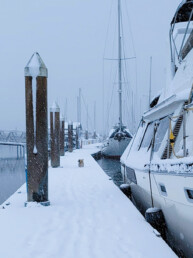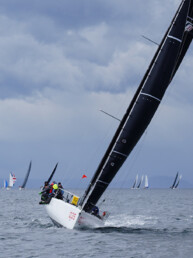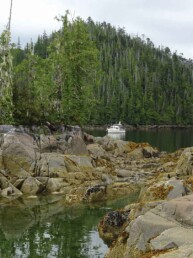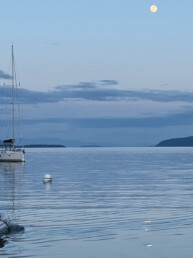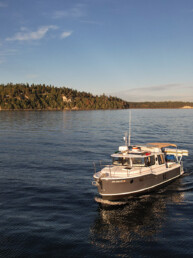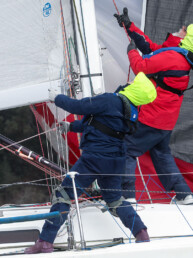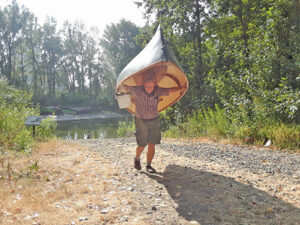
On a rowing trip from Seattle to Port Townsend, I was taking a break atop a bluff, looking out toward Whidbey Island, when I noticed a 18-foot, gaff-rigged sailboat utterly becalmed, but pointing north, the same direction I had been traveling. Suddenly compelled to see said boat, I hurried down to my rowboat and launched with a new purpose.
A short while later, I coasted up to the craft to find its captain calmly reading a book in the shade of his sail. Without a motor, he seemed content to bide his time until the wind returned. He exuded an imperturbable sense of tranquility, as if he belonged in that very spot. We exchanged names and pleasantries and asked about each others’ boats. As I departed, I handed my new acquaintance, Tim, a bag of homemade cookies.
A year later, I finally met Tim on land after posting a story on my blog about fabricating a crude home-made mast traveler for my new boat. Appalled at the high cost of importing a commercially made model from England, I was still obsessed with owning one. That was when Tim reached out to help. Not only did he live about 10 miles from my home, but he would be happy to make one for me. I was thrilled at Tim’s thoughtfulness and excited to have a new sailing friend nearby.
Tim joined my crew of sail and oar explorers, often showing up with a 12-foot fiberglass peapod. Despite its diminutive size, it had a tiny mizzen sail and a modest mainsail. And thanks to Tim’s boat handling skills and ability to read currents, the peapod often outpaced boats twice its size. At the end of a sailing session, Tim would often hang around, reviewing the day, modestly offering tips, or just studying our boats, on the prowl for improvements. I learned that tinkering and improvising a fix is one of his strengths.
When I was on the hunt for a slightly larger boat, I went alone to investigate a bargain before someone else snatched it up. The hull was beautiful, but the water and rot inside were off-putting. When I began to feel overwhelmed at the prospect of tackling this project, I called Tim. He sounded more excited about the boat than I did, and he was ready to advise.
“Did you bring a mallet,” he asked over the phone.
I was perplexed. “Why would I have brought a mallet? I’m here to buy the boat, not build it.”
“To understand how solid they are, you have to tap the planks and the keel,” Tim coached from 200 miles away. “What kind of tone do they make?”
Even after tapping away, I had a hard time deciding whether buying the boat was a good idea, or too risky.
“I’m sure we can fix it,” Tim said, exuding his typical positivity. His use of the word “we” gave me the confidence to make the purchase.
After the boat was mine, and I was flummoxed about how to tune the unfamiliar rig, Tim invited me to bring it up to his place. As I rolled into his driveway, I spotted my friend in his typical uniform of a collared shirt, Carhartts, and lace-up loafers. He gave an appraising look at the boat, and I could see that he was already relishing the challenge of adjusting it to perfection.
Tim is the type of person who is happiest when busy. In the decade’s worth of photos I’ve snapped of him in action, he’s generally doing something on a boat. The majority of the photos are blurred: Tim’s hands in motion tying a complex, useful knot, swinging a large tool box from a block and tackle into a second-story sail loft, or hefting a dinghy, turtle-like, onto his back.
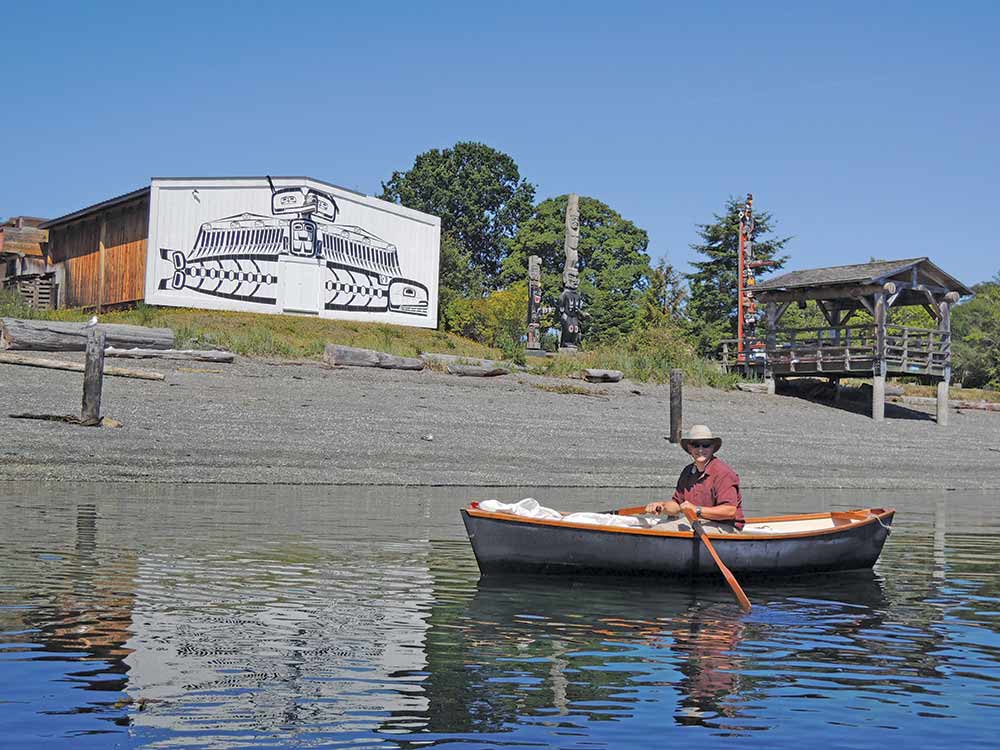
Tim has been involved with plenty of big boats, personally and professionally. But his heart belongs to a string of small wooden boats, ranging from a fast but leaky Sparkman & Stephens racing dinghy to a handsome Herreshoff rowing boat. This passion for small boats is likely the reason our lives keep intersecting, and for that I am thankful.
When I had a sabbatical from work and contemplated a voyage on the Inside Passage, Tim offered me the use of his favorite sailboat, Mr. Mallard. Intrigued by its cozy cabin and salty look, I was both excited and daunted. After all, Tim liked this boat so much, he had bought it back after selling it some years prior. Was I capable enough to take Tim up on the generous offer?
In the end, I decided on a boat I already owned. But when I planned a one-way instead of a round trip, Tim hooked my trailer to his truck and dropped me off 300 miles up Vancouver Island. On launch day I was paralyzed by nervous jitters, but he gently pushed me forward, patiently waiting while I thought of a thousand last-minute excuses to avoid getting underway.
I’ve tried to reciprocate Tim’s giving spirit, through rituals like an annual delivery of new nautical books. Tim is a voracious reader with a special interest in boat stories, so when I can find a few tomes that he hasn’t read, I feel I’ve made a small step towards matching the knowledge and skills he has bestowed on me.
Still, I’ve come to realize that I can’t, and shouldn’t, try to balance the scales all the time. There can be joy in giving, as well as grace in receiving. I’ve tried to emulate Tim’s generosity by hosting new sailors on day trips, running a local small-boat listserv, and sharing what I know, even if that’s a lot less technical than what Tim does. Freely shared knowledge and encouragement have been the best gifts I’ve received as a sailor. Passing them along to others brings satisfaction and a sense of wholeness. And who knows, I just might meet a new friend in the process.
Bruce Bateau sails and rows traditional boats with a modern twist in Portland, Oregon. His stories and adventures can be found at www.terrapintales.wordpress.com.
Bruce Bateau
Bruce Bateau sails and rows traditional boats with a modern twist in Portland, Ore. His stories and adventures can be found at www.terrapintales.wordpress.com

